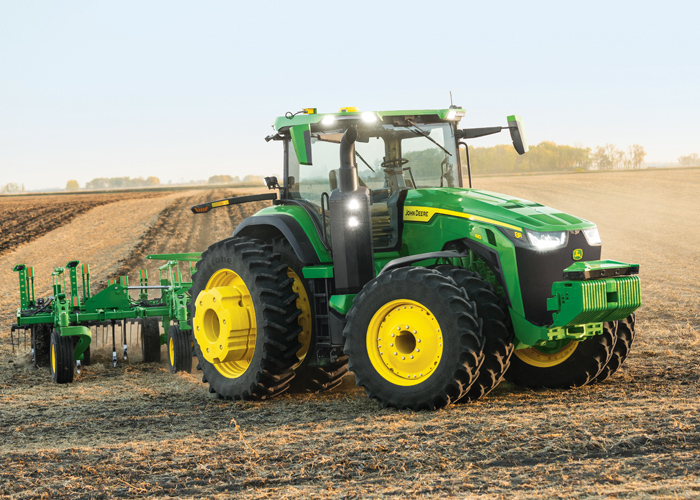Deere unveils fully autonomous 8R tractor

We are only a few weeks in, but it’s been an action-packed start to 2022.
With those in the Ag world eager with anticipation, Deere unveiled their first entirely autonomous tractor for large-scale use on opening day at this year’s CES 2022 Awards in Las Vegas. The Consumer Electronic Show or CES is billed as the world’s most influential technology event, and the new autonomous tractor certainly fits the bill. Deere’s 8R autonomous tractor, currently setup for tillage operation only, combines cameras and GPS guidance with artificial intelligence (AI), machine learning and other new technologies. The tractor is paired with a TruSetTM-enabled chisel plough and StarFire GPS guidance system to deliver a setup intended to meet the demands of broadacre cropping in Australia, all the while without an operator in the cab.
John Deere Australia managing director – Australia & New Zealand Luke Chandler said the tractor was the culmination of industry-leading technology and Deere’s vision to provide tools to help feed a growing global population. “With the world population forecast to increase to nearly 10 billion people by 2050, global food demand is predicted to grow by 50%, meaning farmers will need to be as efficient and sustainable as possible in every phase of production,” Chandler said. “To assist in bridging that gap, John Deere is continually advancing technology to help farmers meet this challenge and to do so while working with reduced access to land and skilled labour, changing climate and weather conditions, variations in soil quality and the presence of weeds and pests. “This autonomous tractor is an extremely exciting innovation that will help to ensure Australian farmers have the opportunity to adopt era-defining AgTech to address these challenges and to support high-performing and sustainable farm businesses.”
Speaking at CES, John Deere chief technical officer Jahmy Hindman said farmers must feed a growing population with less available land and less available labour. “Depending on the crop farmers are growing, it can take seven to 15 passes through a field to produce a healthy and abundant crop,” Hindman said. “To get that done efficiently and in a timely manner, many farmers rely on hired machinery operators and, without fail, finding good, dependable labour is always top of the list of pressure points on the farms that I visit. “With more and more people moving from rural to urban areas, there is an ever-increasing gap between the labour that is needed and the labour available. “(So) the future of agriculture starts now.”
The autonomous tractor operates within less than 2.5cm of accuracy whilst is also has six pairs of stereo cameras which enable 360-degree obstacle detection. The stereo cameras act essentially as a “human eye” to help calculate distance and potential obstacles. The images captured pass through a neural network that classifies each pixel in approximately 100 milliseconds, which then helps the machine determine if it must stop or can continue to work, depending on the obstacle detected. If the detection system brings the tractor to a halt, a notification is sent to the farmer’s phone via the John Deere Operations Center app. Via the Operations Center™ app, farmers will have access to live video, images, data whilst they can also adjust speed, depth and more. In the event of job quality anomalies or machine health issues, farmers are notified remotely and can make adjustments to optimise the performance of the machine.
John Deere production systems manager – Australia & New Zealand Ben Kelly said the introduction of the autonomous tractor is something Australian farmers would embrace. “Globally, Australian farmers have always led in the adoption of AgTech, and as they continue to be faced with limited availability of skilled labour, access to autonomous machinery for large-scale production has never been so important,” Kelly said. “With this new tractor, it is as simple as transporting the machine to a field and configuring it for autonomous operation. “Then, using John Deere Operations Center, farmers can swipe from left to right to start the machine and can leave the field to focus on other tasks, while monitoring its status from their mobile device.” With each pass, the data collected will help create and update a digital map of the paddock it is in – information that can be used for future seasons.
Also speaking at CES, John Deere production and precision ag business vice-president Deanna Kovar said autonomous tractors can handle the work farmers don’t have the time or labour to do. “This isn’t a concept machine, this isn’t a demo, this is a working machine that will be available later this year to farmers (in the US),” Kovar said. “These machines don’t get tired and they don’t call in sick – they can run all day, and if needed, all night. “Autonomy is not a convenience on the farm, it is a necessity to get the job done today and into the future.” Chandler said the tractor will be available to a limited number of US customers for purchase this year, before it is rolled out gradually to other countries, including Australia, “over the next few years.” “As the first commercially-available autonomous solution for large-scale farming operations in the industry, we are excited to see the real-life impact these machines will have on the way we farm and, ultimately, feed the world,” he said. Future production volumes are projected to grow in line with demand as farmers get more access and become more familiar with the technology. Watch this space.







